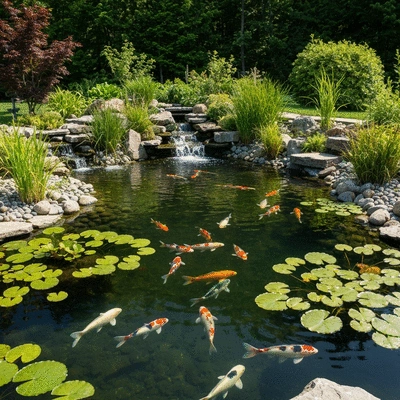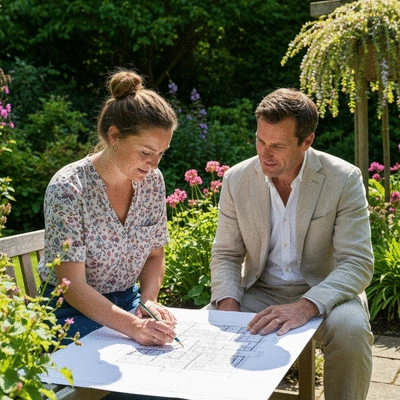Minimum Pond Volume
1,000
Gallons for first Koi
Ensures ample space and better water quality for initial fish.

When planning a koi pond, understanding its shape and size is essential for both aesthetic appeal and the health of your fish. Did you know that the right design can create a thriving ecosystem? Dive into these insights to transform your backyard into a stunning aquatic sanctuary!
Understanding the critical dimensions for your koi pond and appropriate stocking densities ensures a healthy and thriving environment for your fish. Below are the key recommendations:
1,000
Gallons for first Koi
Ensures ample space and better water quality for initial fish.
250
Gallons per Adult Koi
Prevents overcrowding and supports individual fish health.
3
Feet
Helps maintain stable temperatures and protects from predators.
4
Feet
Provides thermal stability during hot summers and cold winters.
When it comes to creating a stunning koi pond, the shape and size are two of the most crucial aspects to consider. The dimensions of your pond can significantly impact not only the aesthetic appeal but also the health of your fish and the overall ecosystem. A well-planned pond leads to a thriving environment where koi can flourish, making it essential to invest time in understanding these elements.
As a koi pond enthusiast, I’ve learned that the right shape and size can enhance water circulation, reduce stagnation, and support a healthy balance of nutrients. It’s fascinating how the right design is not just about beauty; it’s about creating a sustainable habitat for your fish.

In my journey of designing koi ponds, I’ve found that the shape plays a significant role in how effectively water circulates. For example, round ponds tend to allow for better water movement, supporting healthier fish. On the other hand, rectangular ponds provide more space, which can be beneficial for larger koi populations. Size isn’t just a number; it’s about creating an environment tailored to your fish's needs! For a comprehensive guide on choosing the right size, you can refer to The Complete Guide to Choosing the Right Size for Your Koi Pond.
When planning your koi pond, it's essential to consider various environmental and aesthetic factors. For instance, if your backyard gets full sun, a larger pond with deeper areas will help regulate temperature. Moreover, think about how the pond will fit into your overall landscape design. It should not only be a habitat for your koi but also a beautiful feature in your yard.
Often, I'll recommend sketching out your ideas before committing to a design. This planning stage is vital; it helps visualize how your pond will harmonize with the surrounding environment. After all, a koi pond should be a delightful addition to your home—a tranquil retreat that reflects your personal style!
Establishing the right size for your koi pond begins with understanding the needs of your fish. A general guideline is to aim for at least 1,000 gallons for your first koi, ensuring they have enough room to thrive. This capacity not only provides a comfortable living space but also supports better water quality, which is crucial for koi health. Additionally, a minimum depth of 3 feet is important for temperature stability and protection from predators, as discussed in What Is The Average Pond Size?
During my koi pond projects, I’ve noticed that ponds with sufficient depth tend to have happier, healthier fish, and that’s something every koi enthusiast desires!
One common question I receive is, “How many koi can I keep in my pond?” This brings us to the vital concept of stocking density. A good rule of thumb is to allocate about 250 gallons per adult koi. This guideline helps prevent overcrowding and ensures that each fish has enough space to grow and thrive.
When planning your koi pond, reconsidering the number of fish based on pond size is crucial. Remember, more fish means more waste, which can lead to poor water quality. Keeping an optimal number of koi will enhance the overall dynamics of your pond.
Pond depth is an often-overlooked factor that can significantly influence your koi's well-being. The deeper your pond, the less susceptible it is to temperature fluctuations. In regions with hot summers or cold winters, a depth of at least 4 feet can provide a refuge for your fish during extreme weather conditions.
Moreover, deeper water offers better thermal stratification, meaning your koi can find a comfortable layer within the pond. During my experiences, I’ve seen how maintaining a stable temperature can lead to vibrant and active koi, which is always a joy to witness!
As you embark on your koi pond journey, we want to hear from you! What aspect of koi pond design do you find most challenging?
Deciding on the layout of your koi pond is an exciting step in creating your aquatic sanctuary! Whether you're a DIY enthusiast or prefer to leave it to the professionals, understanding when to take each route can make a significant difference. Here’s a guide to help you navigate these choices.
When it comes to installing your koi pond, you might wonder if you should tackle the project yourself or hire a professional. This decision often hinges on a few critical factors:

As I often say, your koi pond should not only be beautiful but also functional. Assessing these factors helps ensure that your investment pays off in the long run!
Creating a stunning koi pond involves several costs to consider. From the initial setup to ongoing maintenance, here are some essential factors that can influence your budget:
Planning your budget carefully ensures that you can enjoy your koi pond without financial surprises. As someone who's experienced the joys and challenges of koi keeping, I recommend mapping out all potential expenses upfront!
Transformations can be incredibly inspiring! Here, I’d like to share some real-life examples of koi pond projects that showcase the amazing changes that can occur:
These transformations not only improved the aesthetics of the gardens but also fostered healthier environments for koi, reinforcing the importance of thoughtful design!
Hearing from fellow koi pond enthusiasts adds a personal touch that can resonate deeply. Here’s what some of our community members had to share about their choices:
These insights from fellow koi keepers highlight the diversity of choices and experiences that come with pond ownership, proving there's no one right way to create a thriving koi sanctuary.
As a koi pond enthusiast, seeing how my pond supports local wildlife has been a rewarding part of the experience. By focusing on biodiversity, we can create not just beautiful environments but also sustainable ones that benefit nature!
Your koi pond journey is truly personal! As you consider your own space and preferences, remember that every decision contributes to a unique aquatic landscape. Don’t be afraid to experiment and express your creativity!
To continue your learning journey, check out various resources we offer at Best Koi Ponds. From guides to community forums, you’ll find the support you need to design and maintain your ideal koi pond. Let’s make your vision a reality!
Here is a quick recap of the important points discussed in the article:
Koi Pond Water Quality Solutions

Did you know that maintaining optimal water quality can significantly extend the lifespan of your ko
Naturalizing Your Koi Pond Plants

Did you know that aquatic plants can significantly enhance the health and beauty of your koi pond? T
Koi Pond Shape and Size Guide
Koi Pond Water Quality Solutions
Naturalizing Your Koi Pond Plants
Koi Pond Equipment: Pumps, Filters, Liners
Koi Pond Water Test Kit Guide